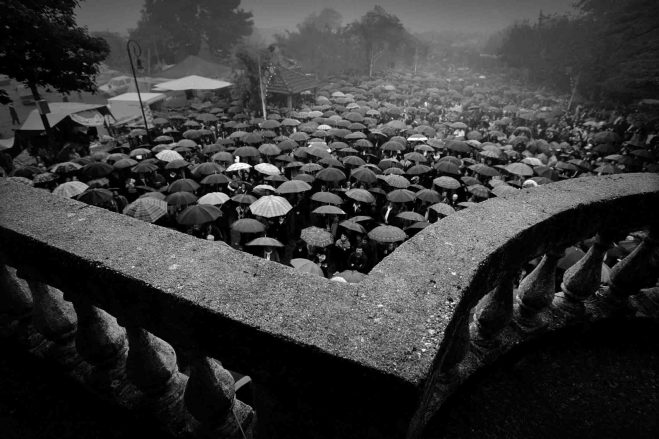
Starting this month, the Leica factory in Vila Nova de Famalicão, Portugal, is celebrating a major anniversary: the plant has been located there for exactly fifty years and complements the production at the traditional company in Wetzlar. However, it is not only the history of technical innovations that is being commemorated; photography itself is also the focus of the jubilee. Less than forty kilometres from the Leica factory, another anniversary is being celebrated: the Leica Gallery in Porto is presenting an exhibition with five decades of works by Alfredo Cunha.
He has worked all over the world, but his homeland has always been at the heart of his photography. Without a doubt, Alfredo Cunha is one of Portugal’s most distinguished photographers. Throughout his long photo-journalistic career, he has followed history with his Leica cameras and created an incomparable archive covering politics, society, cities and landscapes, but, above all, focusing on the people of Portugal. Born in 1953, Cunha’s oeuvre represents a lively chronicle spanning half a decade. A perfect opportunity for gaining insight into his work is the exhibition Portugal from 1973 to 2023: A Work in Progress at the Leica Gallery in Porto, which has just opened and will remain on display until January 2024. The presentation complements the jubilee exhibition From Famalicão into the World: 50 Years of Leica in Portugal, which will be shown at the production plant. Here, too, it is not only about photographic technology and optical innovation, but always about people: the employees at the factory, as well as the photographers who have framed the world with Leica cameras. And, with his passion for Leica cameras, Cunha is one of the most prominent representatives of innovative photography. Remaining true to his visual language, while continuously refining it, he can look back over an outstanding body of life’s work.
An essential key to understanding Cunha’s photography is his direct approach to people: he was influenced by European humanist photographic models early on, and by American photo-journalistic realists a few years later. He was a close observer, who followed political, social and societal developments in Portugal. His photographs taken during the Carnation Revolution after 25 April 1974, are of particular significance. His oeuvre is, above all, a rich chronicle of his homeland, which he documented from its most diverse perspectives: rural work, harvesting, villages and small towns, workshops, festivities, processions and music bands, the contradictions of the big cities, the upheavals with demonstrations and rallies, daily life on the streets. Many things have changed: the country in which he prefers to take photographs and the equipment he uses – from analogue to digital technology, which he has been working with since 2003. In 2020, he also captured experiences of Covid 19 in an emotional series titled Hope. In black and white, as he prefers.
You have always stayed faithful to your preference for black and white.
Black and white is my language since forever. In the polychrome attempts I made during my life, I noticed that colour distracted me from the essential and introduced noise that I consider unnecessary. For me, the essential is the form, not the colours.
During your long career, you have used a variety of cameras. What do you appreciate about Leica?
I have indeed worked with countless cameras, but I always had one or two Leicas. The first was a Leica M3, in 1972. I’ve worked with the M3, M2, M6, and M7. I’ve also worked with the Leicaflex SL, because of its long focal length. Leica cameras are sturdy and they have fantastic optic quality – they are a work tool, but, at the same time, they have also become an extension of my eye. Of course, the lightness and discretion of the M cameras, and now of the Q2 Monochrome, weigh a lot in my preference for these cameras. Besides the Q2 Monochrome, I nowadays use a micro 4/3 camera with Leica Prime lenses – e.g. Summilux 12mm 1.4, Nocticron 42.5 1.2, and also a 100/400 zoom. I love extreme focal lengths – wide lenses and long focal lengths.
What is your opinion about digital photography?
I don’t distinguish between analogue and digital; they’re getting closer. The technique is not important; the resulting image is what matters. I appreciate the democratisation brought on by digital photography. It has allowed the emergence of many new young photographers.
Cunha withdrew from active photojournalism over ten years ago, but there is no sign of his going into retirement. On the contrary, he has been sorting out his archives, publishing numerous photo books, and preparing exhibitions: now in Porto once again. And the title A Work in Progress suggests that we can looked forward to further motifs by the photographer in the years to come.
Alfredo Cunha was born on October 8, 1953 in Celorico da Beira. Influenced by photography in his family, he began working as a professional photographer in advertising in 1970, and started his career as a photojournalist at the newspaper Notícias da Amadora. Subsequently, he worked for many newspapers, magazines and news agencies, and was the official photographer for two Portuguese presidents: Ramalho Eanes and Mário Soares. Since 1972, he has published 30 photo books, and to date continues to develop new personal and editorial projects. He is the recipient of many awards, including the Orden des Infante Don Henrique in 1995. Cunha lives with his family in Vila Verde, close to Braga.
Find further information about the Leica Gallery in Porto here.
A portfolio of Cunha’s work appeared in LFI issue 5/2021.











